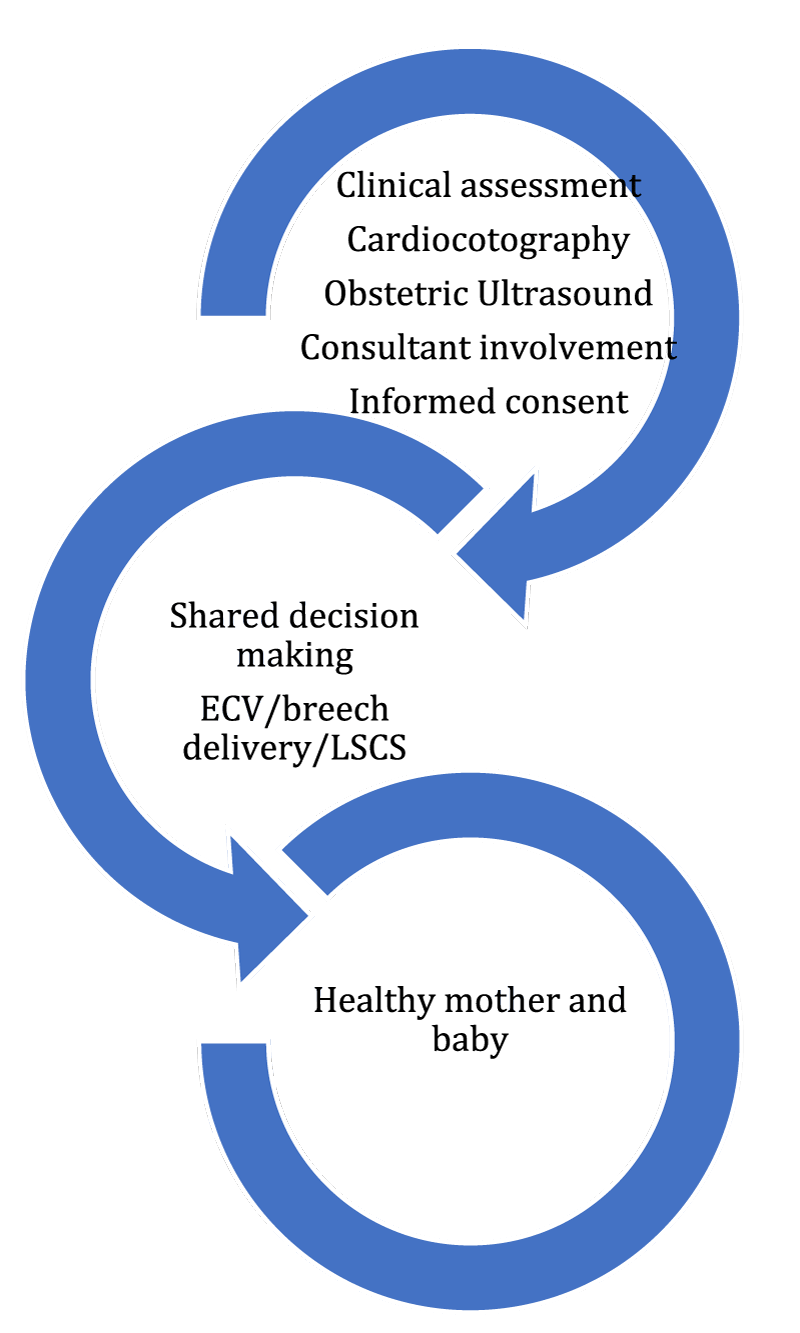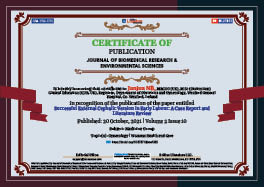> Medicine Group. 2021 October 20;2(10):926-928. doi: 10.37871/jbres1333.
Successful External Cephalic Version in Early Labour: A Case Report and Literature Review
Janjua NB1*, Birmani SA1, Maeve White2, Sarah Siu3 and Asish Das4
2Basic Specialist Trainee, Wexford General Hospital, Co. Wexford, Ireland
3University college Dublin, School of Medicine, Ireland
3Consultant and Head of Department, Wexford General Hospital, Co. Wexford, Ireland
Abstract
Presentation: A 35 year old woman, gravida 7 para 7, all vaginal deliveries, presented with labour pains at 39 weeks’ gestation with intact membranes. Cardiotocograph (CTG) was reassuring.
Diagnosis: Breech presentation was confirmed by an ultrasound.
Treatment: The patient was offered options of External Cephalic Version (ECV) versus (vs) Lower Segment Caesarean Section (LSCS). She opted for ECV which was successful, followed by controlled artificial rupture of membranes. She delivered a healthy baby girl vaginally and was discharged home on day 1 postpartum.
Conclusion: Although intrapartum ECV is not recommended routinely, there is a place for its judicious use in selective cases. The prerequisites include an experienced obstetrician, reassuring CTG, previous vaginal delivery, no obstetric indication for performing LSCS, adequate amniotic fluid volume with intact membranes, early labour, and informed maternal consent. We recommend keeping theatre on standby while performing ECV in case an obstetric complication arises.
Introduction
Although the breech presentation is common in term pregnancies, there is no consensus on the suitable delivery option (ECV, breech delivery, and LSCS). ECV is a widely accepted and safe procedure. We report this case because intrapartum ECV is rarely performed and not recommended routinely, however, the successful outcome in this particular case emphasizes considering it as a viable option in selective cases.
Case Report
A 35 years old, gravida 7 para 7, with all vaginal deliveries including one twin delivery, and successful ECV in last pregnancy, was booked at 18 weeks’ gestation with a body mass index of 29 Kg/m2. The oral glucose tolerance test was normal at 29 weeks of pregnancy.
Ultrasound at 35 weeks showed an estimated foetal weight on the 76th centile and polyhydramnios (38 cm amniotic fluid index).
She came in early labour at 39 weeks’ gestation, with a breech presentation. CTG was reassuring. A vaginal examination revealed a fully effaced and 1 cm dilated cervix with bulging membranes. Thus, options of ECV vs LSCS were discussed, including the risks and benefits of each, and she opted for ECV.
After maintaining the intravenous line, taking blood for group & save, and making the theatre standby, successful ultrasound-guided ECV was performed. It was followed by a controlled artificial rupture of membranes. CTG was reassuring before and after ECV. Two and a half hours post ECV, she had a vaginal delivery of a 3.7 kg baby girl with APGAR scores of 9 at 1 minute and 10 at 5 minutes. Both mother and baby were discharged home well on day 1 postpartum.
Discussion
Various delivery methods for breech presentation at term are used worldwide, according to local guidelines and patients’ preferences. Although ECV is a well-known method [1], it is rarely used in labour.
ECV should be considered for women with malpresentation beyond 36 weeks, reassuring foetal status and suitable for vaginal delivery.
Favourable factors for the success of ECV include multiparity, adequate Amniotic Fluid (AF), and unengaged presenting part. Adverse factors are: advanced cervical dilatation, estimated foetal weight less than 2.5 Kg, ruptured membranes, and maternal obesity [2]. Although the use of tocolysis with betamimetics improves the success rates of ECV [3], we did not use it in our case as the patient was in labour.
The complications of ECV (Table 1) vary from foetal distress and emergency LSCS to uterine rupture and foetal death [4]. Albeit their rate is low [4,5].
| Table 1: The complications of external cephalic version. | |
| Maternal | Foetal & Neonatal |
| Antepartum haemorrhage Placental abruption |
Transient CTG abnormalities Ruptured membranes |
| Emergency LSCS Reversion back to breech after successful ECV |
Foeto-maternal transfusion Foetal distress requiring emergency LSCS |
| Uterine torsion | Cord prolapse |
| Uterine rupture | Foetal Injury (e.g. fractured foetal bones) |
| Maternal morbidity and mortality | Admission in neonatal intensive care unit |
| Psychological Trauma | Foetal death |
The benefits of ECV include reducing non-cephalic presentation at birth, increasing the chance of vaginal delivery, and avoiding the morbidity associated with LSCS [5-7].
Breech delivery was not offered to the mother as it is not part of the protocol at our unit.
Literature review suggests few case series reporting the success of intrapartum ECV, with no untoward maternal and foetal outcomes [2,8,9] Shanahan MM & Gray CJ suggested the role of ECV for breech presentation in labour [10].
Choosing the optimal mode of birth for the woman with breech presentation in early labour must be shared and informed decision between the patient and clinician, taking into account the local guidelines and facilities for foeto-maternal surveillance. We propose a model of care for “Breech in Early Labour” (Figure 1). Ensuring the availability of CTG, ultrasound, obstetric expertise, and facility for LSCS are of paramount importance while planning for intrapartum ECV.
Acknowledgments
- Professor Dr Naveed Kausar Janjua, Chemistry Department, Quaid-i-Azam University, Islamabad, Pakistan.
- Matthew McKernan, Consultant and Head of Department, Letterkenny University Hospital, Letterkenny. Ireland
- Sandhya Babu, Consultant, Department of Obstetrics and Gynecology, Wexford General Hospital, Co. Wexford. Ireland.
Conflicts of Interest
The authors declare that there are no financial interests or connections, direct or indirect, or other situations that might raise the question of bias in the work reported or the conclusions, implications or opinions stated-including pertinent commercial or other sources of funding for the individual author(s) or the associated department(s) or organization(s), personal relationships, or direct academic competition.
References
- Gaiser RM. External cephalic version. Consult Obstet Anesthesiol. 2018;58(3):197-198. https://tinyurl.com/462xefp2
- Fortunato SJ, Mercer LJ, Guzick DS. External cephalic version with tocolysis: factors associated with success. Obstet Gynecol. 1988 Jul;72(1):59-62. PMID: 3288930.
- External Cephalic Version and Reducing the Incidence of Term Breech Presentation: Green-top Guideline No. 20a. BJOG. 2017 Jun;124(7):e178-e192. doi: 10.1111/1471-0528.14466. Epub 2017 Mar 16. PMID: 28299867.
- Rodgers R, Beik N, Nassar N, Brito I, de Vries B. Complications of external cephalic version: a retrospective analysis of 1121 patients at a tertiary hospital in Sydney. BJOG. 2017 Apr;124(5):767-772. doi: 10.1111/1471-0528.14169. Epub 2016 Jun 16. PMID: 27306144.
- Melo P, Georgiou EX, Hedditch A, Ellaway P, Impey L. External cephalic version at term: a cohort study of 18 years' experience. BJOG. 2019 Mar;126(4):493-499. doi: 10.1111/1471-0528.15475. Epub 2018 Oct 23. PMID: 30223309.
- Hofmeyr GJ, Kulier R, West HM. External cephalic version for breech presentation at term. Cochrane Database Syst Rev. 2015;2016(3).
- Ducarme G. Présentation du siège. Recommandations pour la pratique clinique du CNGOF — Version par manœuvre externe et techniques de version alternatives [Breech Presentation: CNGOF Guidelines for Clinical Practice - External Cephalic Version and other Interventions to turn Breech Babies to Cephalic Presentation]. Gynecol Obstet Fertil Senol. 2020 Jan;48(1):81-94. French. doi: 10.1016/j.gofs.2019.10.024. Epub 2019 Oct 31. PMID: 31678503.
- Ferguson JE 2nd, Dyson DC. Intrapartum external cephalic version. Am J Obstet Gynecol. 1985 Jun 1;152(3):297-8. doi: 10.1016/s0002-9378(85)80214-3. PMID: 4003475.
- El‐Muzaini MF, Felimban HM, Al‐Hazmi NM, Shabaan LA, Namankani FY, Fathudein MA. Breech in labor, to turn or not to turn?. BJOG: An international journal of obstetrics and gynaecology. 2008;115(s1):77. https://tinyurl.com/53krytvt
- Dalley G. External cephalic version. Lancet. 1953;262(6785):573. doi: 10.1016/S0140-6736(53)90223-2
Content Alerts
SignUp to our
Content alerts.
 This work is licensed under a Creative Commons Attribution 4.0 International License.
This work is licensed under a Creative Commons Attribution 4.0 International License.









